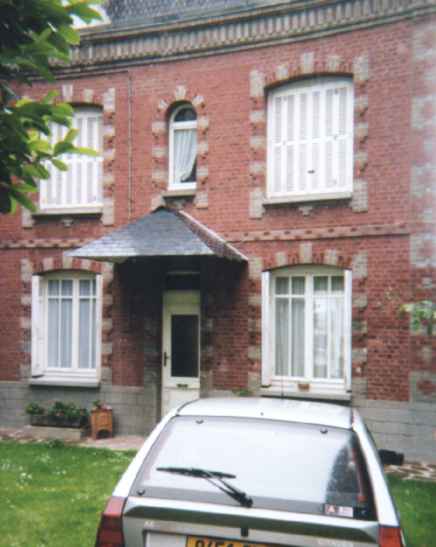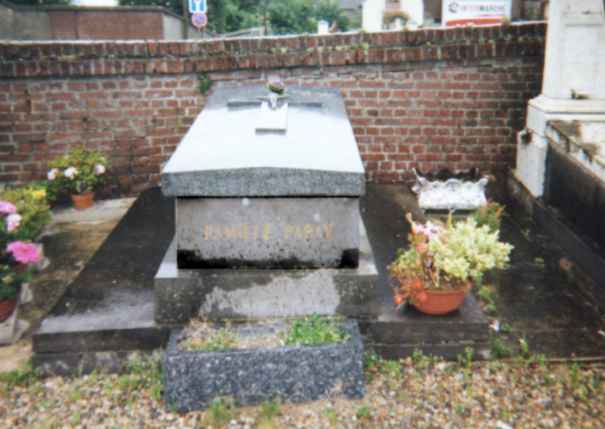Paul Paray
French Composer and Conductor
Grand Prix de Rome
Member of the Institute
Grand-Croix de la Légion d'Honneur
Grand-Croix de l'Ordre nationale du Mérite
A Biographical Chronology by Jacques Paray
1886
Paul Paray was born in LE TRÉPORT, near Rouen, on May 24th.
His father Auguste PARAY, a professional ivory sculptor, joined music
to his artistic abilities. He was the organist of St. Jacques Church,
Tréport, Director of the municipal band and of the Orphéon
Theater. He gave complete performances of works such as
The Creation by Haydn, La Rédemption of Gounod and
L'Enfance du Christ by Berlioz with the assistance of soloists from the
Opéra. He also composed secular and religious music, and on occasion
wrote poetry. Paul's mother, Hortense PICARD, was the sister of Father A. PICARD,
Vicar General of ROUEN; both were born and died at Tréport. Paul's elder
brother, Auguste Paray (my own father), was a music professor at ROUEN and organist of its
Cathedral, as well as an orchestral conductor for several municipal theaters such as Mulhouse,
Carcassonne, the Casino of VICHY (1927-1934) and the Opéra of Lyons and
Nantes. His younger sister, Marie, an excellent pianist, died prematurely at the age of
33. All three children had their father as their first teacher.
1895
Paul Paray joined his brother Auguste at the Maitrise St. Evode of the ROUEN
Cathedral. He perfected his musical knowledge by the study of Gregorian chant and polyphony,
and immersed himself in the music of J.S. BACH, which he played nearly in its entirety by heart
by the age of 16. Although he preferred the organ, he excelled both in piano and
cello. At the age of 14 he composed his first Magnificat, which is still sung at the
ROUEN Cathedral on major feast days.
1904
He entered the Paris Conservatory to study harmony with Xavier
LEROUX, and then studied counterpoint and composition with Georges CAUSSADE.
1911
Wrote Yanitza and won the Grand Prix de Rome.
1912
Traveled to Italy to study at the Villa Medici in Rome.
1914
Entered the army and was subsequently made prisoner of war.
1920
Appointed assistant conductor to Camille Chevillard at the Concerts LAMOUREUX
in Paris.
1923
Elected Chief Conductor of the Association of the Concerts LAMOUREUX.
1928
Was made Music Director at the Casino of MONTE-CARLO (until 1932), and during
the summer was Director of Music at the Grand Casino of VICHY.
1932
Succeeded Gabriel PIERNÉ as Chief Conductor of the Concerts COLONNE,
Paris. In the same year he became a conductor of the Paris Opéra.
1939
Paray was sent by the French government to the World's Fair in New York to represent
France in a concert with the New York Philharmonic. He was asked at this time to
become the successor to Toscanini.
The Colonne and Lamoureux orchestras merged under the direction of Paul PARAY
and Eugène BIGOT.
1940
Conducted the French Radio Orchestra at Limoges and Marseilles, but refused to
conduct in Paris during German occupation. He refused to give out the names of Jewish
musicians of the orchestra and resigned.
Afterwards he went to the Principality of MONACO and, with his wife, devoted himself to
helping musicians in need of his support. Paray hired several musicians in difficult
straits for the Monaco Orchestra. Both Free France and Occupied France appreciated the nobility
of this deed.
The following story will illustrate his character:
In 1942, the Berlin Symphony Orchestra came to play in Lyons. Another concert, of
French music, was organized the following day, and Paray was requested to conduct it.
Many listeners applauded the Sorcerer's Apprentice by Paul Dukas (a Jew). At
the end of the evening the enthusiastic public applauded unceasingly. The Maestro then
said to the musicians, "Stand up! Let's have the Marseillaise, in B-flat." Then he
turned towards the audience and conducted them. The strains of the national anthem
soared, resounding on the stage and in the hall.
1944
After the liberation, returning to Paris, Paray expressed his emotion to the public, his
happiness to be in a free Paris conducting the Concerts Colonne Orchestra which [just] then had
gotten its name and leader back. (The Germans had changed it from Colonne, a name of
Jewish origin, to that of Gabriel Piernél;, the previous conductor of the ensemble.
1945
Serge KOUSSEVITZKY invited Pary to lead the Boston Symphony Orchestra,
remembering his brilliant performances before the war. Despite pressure put on him,
Paray did not yet accept to lead any of the major orchestras that were offered to him in the United
States, hesitating to leave his country. But would return often to the United States.
1949
He conducted the Israel Philharmonic for five months. He would continue to
appear before them for at least one month every year until his death.
1950
Paul Paray elected to the Institute.
1951
Selected as Music Director of the newly-reconstituted
Detroit Symphony Orchestra, a
post he would hold until 1963 winter season. There he was entrusted with the task of
creating a polished ensemble, following successes with the orchestras of New York, Boston,
Philadelphia, Cincinnati, Chicago and Pittsburgh, which he had led since 1945. During
the next decade he made the Detroit Symphony one of the best in the United States, and
performed with it in more than 30 U.S. cities.
1955
Unable to cope with so many concerts, he declined to assume Directorship of the
Concerts Colonne, to which he had been returning frequently.
1963
Resuming his career as a guest conductor, and in order to answer all the requests for
conducting appearances, Paray left Detroit and established residence in Monaco. His
guest conducting invitations included tours of Europe, the United States and the U.S.S.R.
1979
Stricken by a heart attack upon a return from Austria, Paul Paray passed away on the
tenth of October, one day before he was to travel to give two concerts in Monaco and
Paris. He now rests in Le Tréport, which he never forgot,
and which was so often in his mind when conducting Debussy's La Mer
Jacques Paray is a nephew of Paul Paray
Return to Paray main page.

Le Tréport
Paul Paray has not been forgotten by his birthplace. At No.
88 Rue Alexandre Papin visitors will find the Paul Paray School of Music
(the second floor of photo below left), the Paray family home at No. 66
(center photo), and one street south Avenue Paul Paray, which meets (at various
points) Avenue Bizet., Avenue Massenet, Avenue Berlioz, Avenue Maurice Ravel
(which soon becomes Avenue Camille Saint-Säens),
and Avenue Charles Gonoud.
At the bend where Avenue Paul Paray becomes the Route de Diepe
is found the Paray family plot (right photo).



Photos supplied by Walter Nones, taken June 1999




